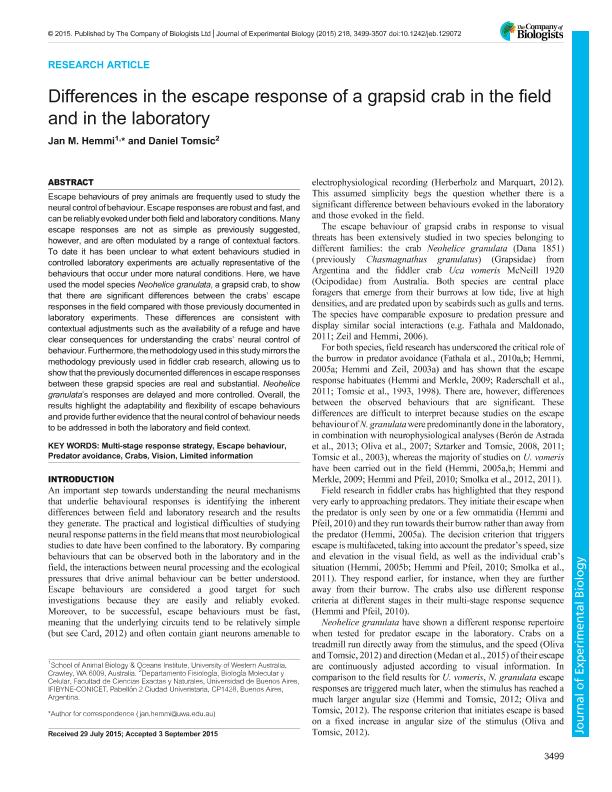Mostrar el registro sencillo del ítem
dc.contributor.author
Hemmi, J. M.
dc.contributor.author
Tomsic, Daniel

dc.date.available
2018-05-11T21:10:42Z
dc.date.issued
2015-09
dc.identifier.citation
Hemmi, J. M.; Tomsic, Daniel; Differences in the escape response of a grapsid crab in the field and in the laboratory; Company of Biologists; Journal of Experimental Biology; 218; 21; 9-2015; 3499-3507
dc.identifier.issn
0022-0949
dc.identifier.uri
http://hdl.handle.net/11336/44996
dc.description.abstract
Escape behaviours of prey animals are frequently used to study the neural control of behaviour. Escape responses are robust, fast, and can be reliably evoked under both field and laboratory conditions. Many escape responses are not as simple as previously suggested, however, and are often modulated by a range of contextual factors. To date it has been unclear to what extent behaviours studied in controlled laboratory experiments are actually representative of the behaviours that occur under more natural conditions. Here we have used the model species, Neohelice granulata, a grapsid crab, to show that there are significant differences between the crabs' escape responses in the field compared to those previously documented in laboratory experiments. These differences are consistent with contextual adjustments such as the availability of a refuge and have clear consequences for understanding the crabs' neural control of behaviour. Furthermore, the methodology used in this study mirrors the methodology previously used in fiddler crab research, allowing us to show that the previously documented differences in escape responses between these grapsid species are real and substantial. Neohelice's responses are delayed and more controlled. Overall, the results highlight the adaptability and flexibility of escape behaviours and provide further evidence that the neural control of behaviour needs to be address in both the laboratory and field context.
dc.format
application/pdf
dc.language.iso
eng
dc.publisher
Company of Biologists

dc.rights
info:eu-repo/semantics/openAccess
dc.rights.uri
https://creativecommons.org/licenses/by-nc-sa/2.5/ar/
dc.subject
Behavior
dc.subject
Escape
dc.subject
Vision
dc.subject.classification
Otras Ciencias Biológicas

dc.subject.classification
Ciencias Biológicas

dc.subject.classification
CIENCIAS NATURALES Y EXACTAS

dc.title
Differences in the escape response of a grapsid crab in the field and in the laboratory
dc.type
info:eu-repo/semantics/article
dc.type
info:ar-repo/semantics/artículo
dc.type
info:eu-repo/semantics/publishedVersion
dc.date.updated
2018-05-11T20:54:41Z
dc.journal.volume
218
dc.journal.number
21
dc.journal.pagination
3499-3507
dc.journal.pais
Reino Unido

dc.journal.ciudad
Cambridge
dc.description.fil
Fil: Hemmi, J. M.. University of Western Australia; Australia
dc.description.fil
Fil: Tomsic, Daniel. Consejo Nacional de Investigaciones Científicas y Técnicas. Oficina de Coordinación Administrativa Ciudad Universitaria. Instituto de Fisiología, Biología Molecular y Neurociencias. Universidad de Buenos Aires. Facultad de Ciencias Exactas y Naturales. Instituto de Fisiología, Biología Molecular y Neurociencias; Argentina
dc.journal.title
Journal of Experimental Biology

dc.relation.alternativeid
info:eu-repo/semantics/altIdentifier/url/http://jeb.biologists.org/content/early/2015/09/16/jeb.129072
dc.relation.alternativeid
info:eu-repo/semantics/altIdentifier/doi/http://dx.doi.org/10.1242/jeb.129072
Archivos asociados
